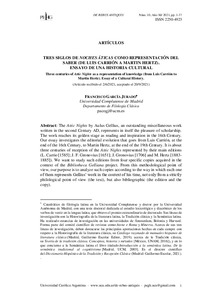Por favor, use este identificador para citar o enlazar este ítem:
https://repositorio.uca.edu.ar/handle/123456789/17283| Campo DC | Valor | Lengua/Idioma |
|---|---|---|
| dc.contributor.author | García Jurado, Francisco | es |
| dc.date.accessioned | 2023-10-12T12:30:17Z | - |
| dc.date.available | 2023-10-12T12:30:17Z | - |
| dc.date.issued | 2021 | - |
| dc.identifier.citation | García Jurado, F. Tres siglos de Noches Áticas como representación del saber (de Luis Carrión a Martin Hertz) : ensayo de una historia cultural [en línea]. De Rebus Antiquis. 2021, 10. Disponible en: https://repositorio.uca.edu.ar/handle/123456789/17283 | es |
| dc.identifier.issn | 2250-4923 | - |
| dc.identifier.uri | https://repositorio.uca.edu.ar/handle/123456789/17283 | - |
| dc.description.abstract | Resumen: Las Noches áticas de Aulo Gelio, una importante obra miscelánea escrita en el siglo II de nuestra era, representa en sí misma el placer de la erudición. La obra alcanza su etapa dorada como lectura e inspiración en el siglo XVI. Este trabajo indaga en la evolución editorial que va desde Luis Carrión, a finales del siglo XVI, hasta Martin Hertz, a finales del siglo XIX. Se trata de tres siglos de recepción de las Noches áticas representadas por sus principales ediciones (L. Carrio [1585]; J. F. Gronovius [1651]; J. Gronovius [1706] y M. Hertz [1883-1885]). Queremos estudiar tales ediciones a partir de cuatro ejemplares concretos adquiridos en el contexto del proyecto Bibliotheca Gelliana. Desde el punto de vista metodológico, nuestro propósito es el análisis de tales ejemplares según la manera en que cada uno de ellos representa la obra de Gelio en el contexto de su época, no solo desde el punto de vista estrictamente filológico (el texto), sino también bibliográfico (la edición y el ejemplar). | es |
| dc.description.abstract | Abstract: The Attic Nights by Aulus Gellius, an outstanding miscellaneous work written in the second Century AD, represents in itself the pleasure of scholarship. The work reaches its golden stage as reading and inspiration in the 16th Century. Our essay investigates the editorial evolution that goes from Luis Carrión, at the end of the 16th Century, to Martin Hertz, at the end of the 19th Century. It is about three centuries of reception of the Attic Nights represented by their main editions (L. Carrio [1585]; J. F. Gronovius [1651]; J. Gronovius [1706] and M. Hertz [1883-1885]). We want to study such editions from four specific copies acquired in the context of the Bibliotheca Gelliana project. From this methodological point of view, our purpose is to analyze such copies according to the way in which each one of them represents Gellius’ work in the context of his time, not only from a strictly philological point of view (the text), but also bibliographic (the edition and the copy). | es |
| dc.format | application/pdf | es |
| dc.language.iso | spa | es |
| dc.publisher | Pontificia Universidad Católica Argentina. Facultad de Ciencias Sociales. Departamento de Historia. Programa de Estudios Históricos Grecorromanos | es |
| dc.rights | Acceso abierto | * |
| dc.rights.uri | http://creativecommons.org/licenses/by-nc-sa/4.0/ | * |
| dc.source | De Rebus Antiquis. 2021, 10 | es |
| dc.subject | LITERATURA LATINA | es |
| dc.subject | HISTORIA ANTIGUA | es |
| dc.subject | HISTORIA CULTURAL | es |
| dc.subject | ENSAYO LITERARIO | es |
| dc.subject | HUMANISMO | es |
| dc.subject | BARROCO | es |
| dc.title | Tres siglos de Noches Áticas como representación del saber (de Luis Carrión a Martin Hertz) : ensayo de una historia cultural | es |
| dc.title | Three centuries of Attic Nights as a representation of knowledge (from Luis Carrión to Martin Hertz). : essay of a cultural history | es |
| dc.type | Reseña libro | es |
| uca.disciplina | HISTORIA | es |
| uca.issnrd | 1 | es |
| uca.affiliation | Fil: García Jurado, Francisco. Universidad Complutense de Madrid Departamento de Filología Clásica; España | es |
| uca.version | publishedVersion | es |
| item.grantfulltext | open | - |
| item.languageiso639-1 | es | - |
| item.fulltext | With Fulltext | - |
| Aparece en las colecciones: | DRA - 2021 nro. 10 | |
Ficheros en este ítem:
| Fichero | Descripción | Tamaño | Formato | |
|---|---|---|---|---|
| tres-siglos-noches.pdf | 846,67 kB | Adobe PDF |  Visualizar/Abrir |
Visualizaciones de página(s)
30
comprobado en 27-abr-2024
Descarga(s)
21
comprobado en 27-abr-2024
Google ScholarTM
Ver en Google Scholar
Este ítem está sujeto a una Licencia Creative Commons

